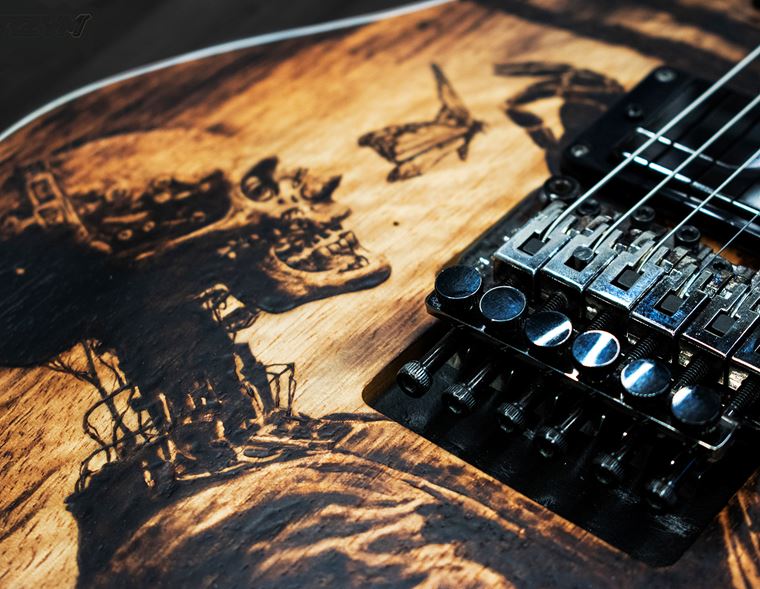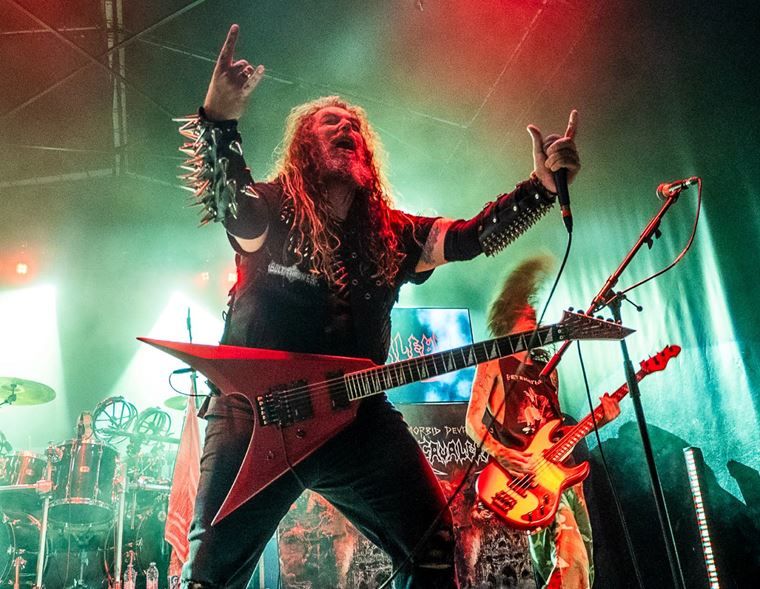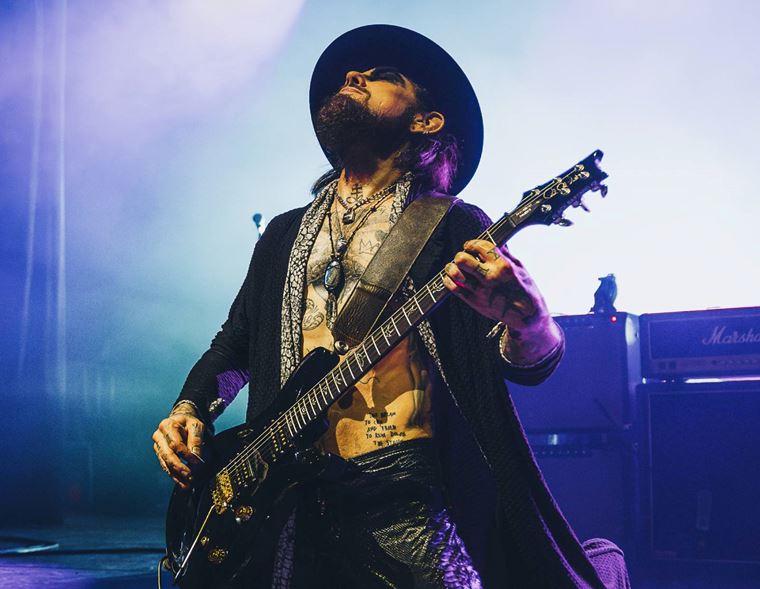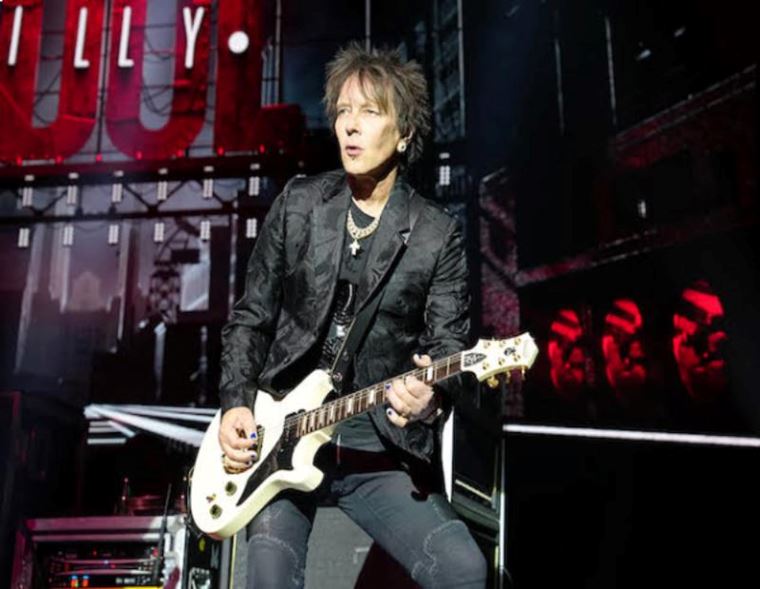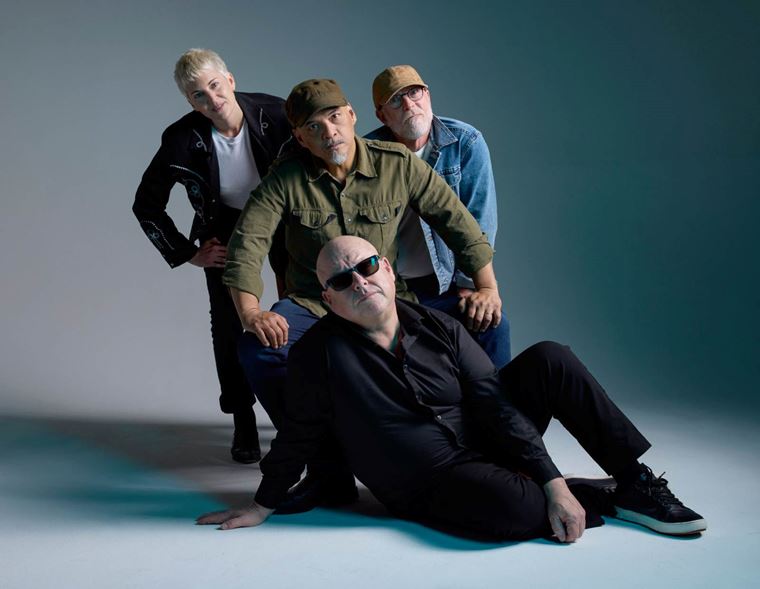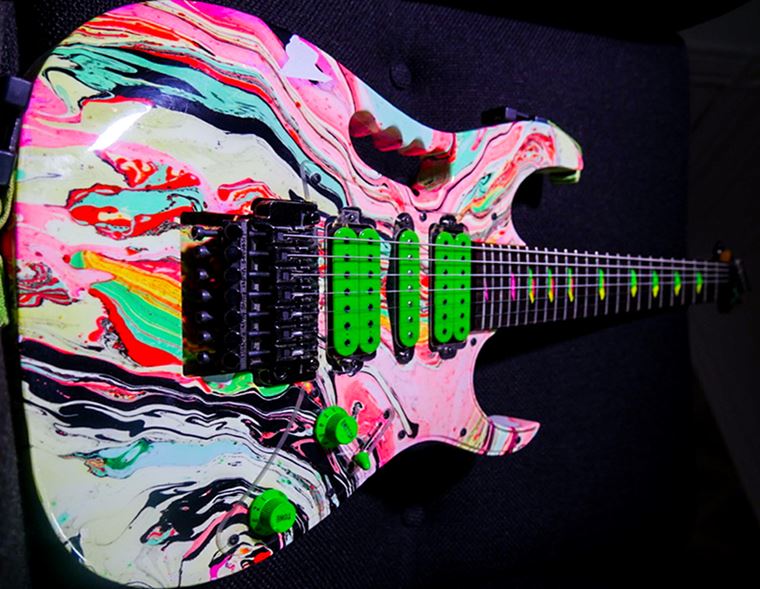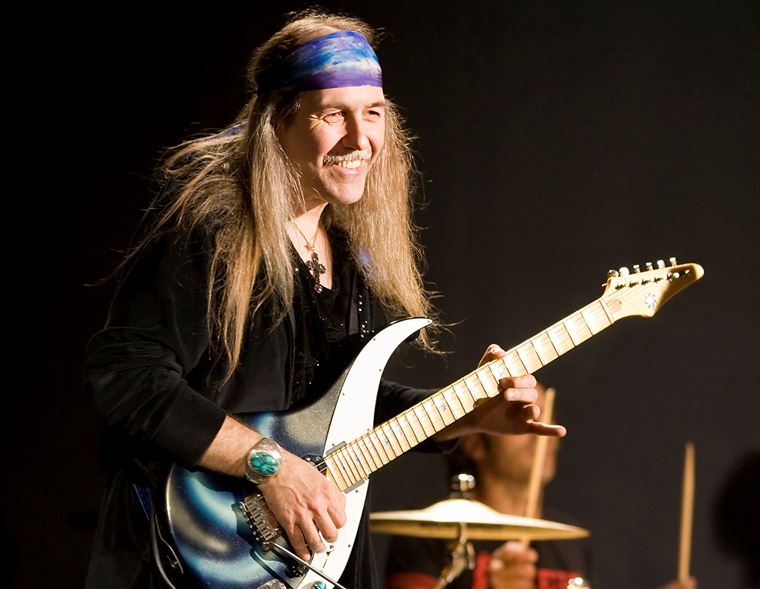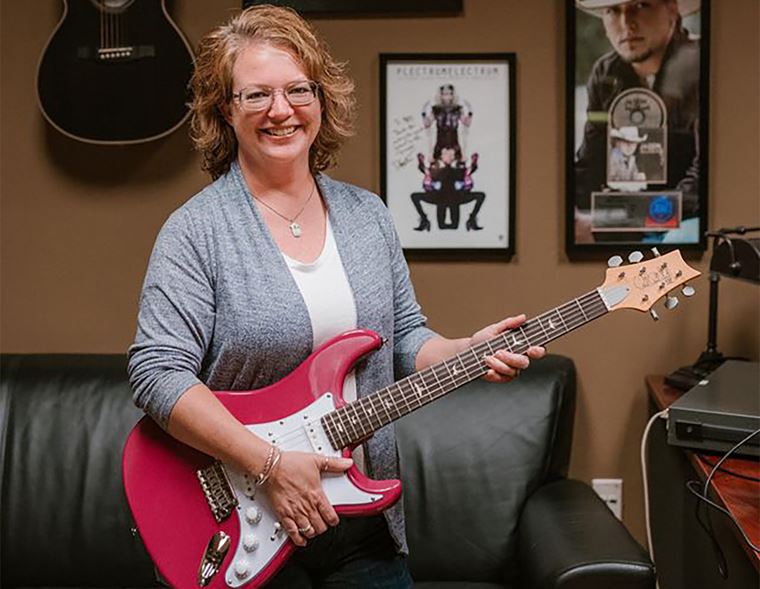Erja Lyytinen EXCLUSIVE Interview! Slide Playing, AI Art and Waiting for the Daylight
From the moment you see the technicolour, expansive cover for Erja Lyytinen’s new record, Waiting For the Daylight, you know it’s going to be an interesting listen! The complex, aquatic-hued art (more on that later) only hints at the colours, textures and dynamics you’ll be treated to when you press play. It’s a bravura statement of intent, as well as an example of an artist working at the height of her powers.
Erja Lyytinen is an outstanding guitar player, but that’s only about a third of the story. A supersonic singer, adventurous songwriter and accomplished producer, Erja’s talents are seemingly endless. Given how guitar-heavy this new record is, it was second nature for us to want an audience with her, to pick apart some of the deeper cuts and moments of inspiration that populate the record. What would such a creative powerhouse be like in person? Friendly? Approachable?
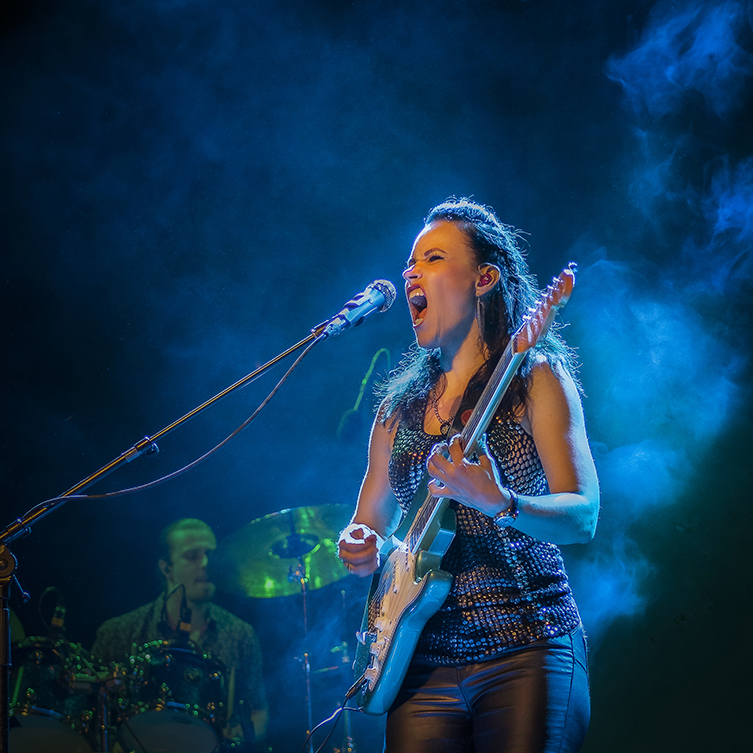
(photo: Juha Säily)
In a word, yes. Erja was very easy and enjoyable company as we laughed our way through our allocated time slot on Zoom. We talked about slide playing (including some good tips!), what’s on her pedal board and also broader subjects like stepping up to produce the record this time, and even artificial intelligence! It’s a wide-ranging interview, which is perhaps appropriate, given the nature of her music.
Without further ado, here is our conversation…
Erja Lyytinen Interview
guitarguitar: So, congratulations on this brilliant sounding new album, it’s epic! I suppose the first thing I’d like to ask you is: this time out, you produced it yourself. That’s on top of being the primary songwriter, singer, guitar player, arranger, the whole bit. How did you find that process, including the extra responsibility and the extra pressure?
Erja Lyytinen: Well, it was interesting, it was challenging, it was very creative, inspiring. Like you said, I carried all of those different parts on my shoulders, so to speak, so I had to take the responsibility for the whole project of the album. By the same token, it was so rewarding. I was so close to each little detail on the album, so I knew what was happening where, and what we needed to do. It was really interesting, and I was so into the album making that I basically didn’t leave my studio for a few months! Working like crazy for hours each day, and when others went out to celebrate May 1st, I was still in the studio all night! (laughs) But it was so cool and so much fun to come up with these different guitar parts, exploring a lot of things and using lots of different effects.
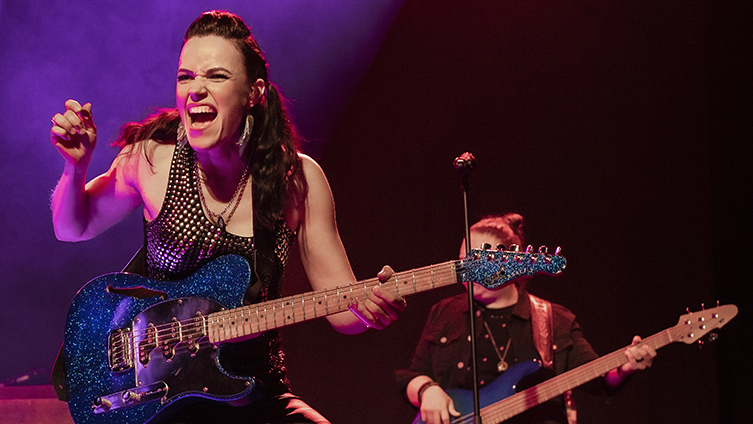
(photo: Juha Säily)
I was recording most of the guitar tracks through my Fender ’68 Super Reverb and I was using two microphones in front of the speakers: Audio Technica 4050 and then I had a Shure SM57, so I had two mics and I could combine those two together to create the sound I wanted. It was really interesting to take the whole responsibility of recording my own guitar tracks, but I think it sounds great on the album, so I’m like, ‘Yeah! Well done, me!’ (laughs) So why not? When I was choosing effects, I didn’t always use the ones I use when playing live. It’s a different thing: when you’re in the studio, you hear more precisely, what’s happening in the sound and what the song requires. It’s so fascinating, I’m still excited about it!
GG: Yeah!
EL: But it was tough! Let me tell you, it was a huge responsibility. I was thinking, ‘do I really want to go through this again on my next album?’ I’m not sure! Hahaha!
GG: Ah, right, right!
EL: You know, it was a lot of work, but then again, I’m so pleased with the album and the sounds. I’ve never been this happy about the final product.
GG: Brilliant! Well, you should be because it’s such a kaleidoscopic and colourful record. I have my little sheet of questions here and you’ve answered a bunch of them already! I must go back over things, but let’s talk about these guitar sounds. You were in charge of them – well, you would be anyway – but does that mean that, normally speaking, there would be someone else that you would use as a sort of sounding board for opinions? Like, is this as good as I can get it? Now, since you’re producing, that other person might be removed, leaving only yourself to rely on for that?
EL: Yes, that’s the tricky part: you need to know! (laughs) Or at least, you need to trust that you know what you’re doing! If you go wrong, do it in a big way so all the wrong parts sound great! I actually bought this Chinese pedal, just a few bucks, so to speak! Just a few euros, and it had been modified slightly by this guitar luthier. It’s a Mosky.
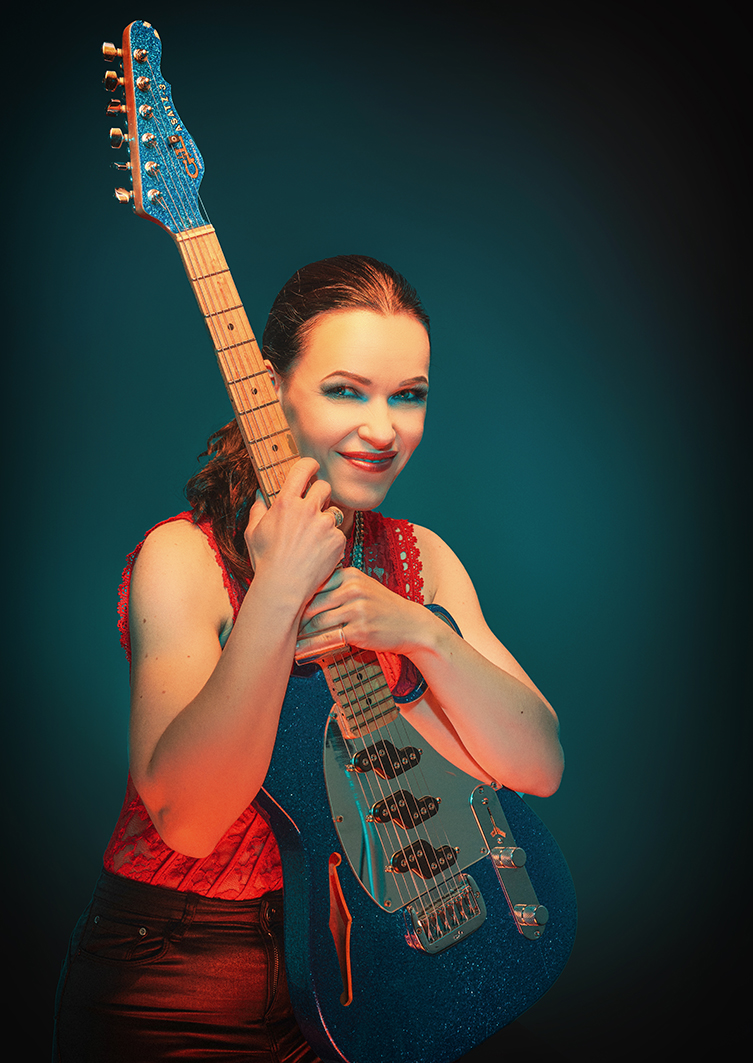
(photo: Antti Karppinen)
GG: Ah, yes. It’s a clone of a Klon Centaur, right?
EL: What is that?
GG: It’s a really famous overdrive from the 90s. People pay scandalous amounts of cash for the originals.
EL: Ah, so you think this is a copy?
GG: Yeah, but there are loads of them out there. We call them Klones with a ‘K’, and they’re normally all really good.
EL: This one is called the Golden Horse. The guy said to me that it works best when you have another distortion pedal combined with it. I wouldn’t normally use this in my shows, but on the song Never Really Have You, I used this combined with a Mad Professor overdrive. So I was using this one and the Chinese one. Finland and China combined together! (laughs!) So that was for the slide guitar. But it doesn’t always have to be so compressed and so distorted, it depends on what you’re doing and what you want.
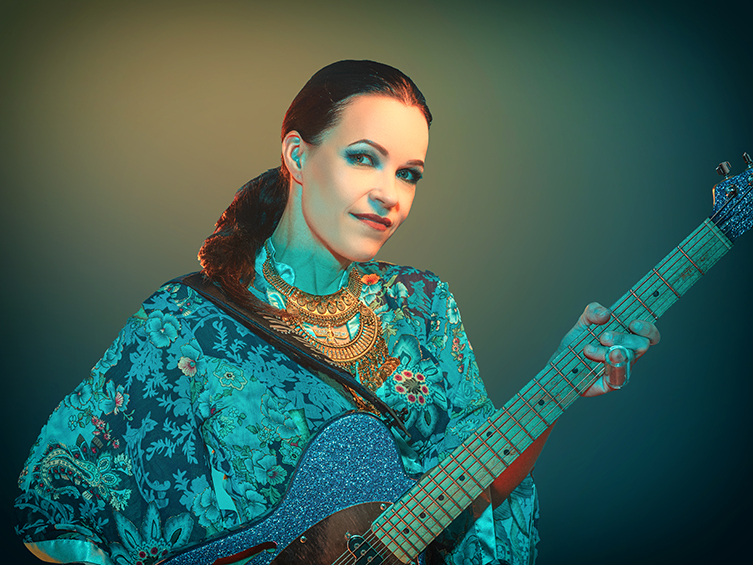
(photo: Antti Karppinen)
GG: Absolutely.
EL: Again, we are talking about making an album, so it’s a completely different thing from live. My pedal boards are here, can you see? (Erjah moves her camera to show her pedalboard on the ground).
GG: Yes I can!
EL: There’s two pedalboards combined together because, when I fly, it’s easier for me to carry them separately. Plus, when you do live shows, I don’t have to have 28kg in the one package. So I have a lot of pedals, as you can see! So I have some more recent pedals I have been using. I have the Keeley Dyno My Roto pedal, I love it and use it live quite a lot. Then I have a tremolo, Super-ego: this is very cool, by Electro-Harmonix. I created some nice airy sounds with it. I used it on Bad Seed on the new record. Then there are Choruses and Tremoloes. The other pedal board has my Fulltone wah-wah pedal: I’m using that on Diamond on the Road, the funny track that’s up-tempo towards the end.
GG; Yeah, of course.
EL: One of the rootsy-est songs on the album. Also, on live shows, I would use the (Mad Professor) Little Green Wonder, combined with the SL Drive by Xotic. It’s a very cool combination. The Whammy has been a favourite for years, because with this, I might drop the key one whole step down. On the song You Talk Dirty, I’m using the Whammy a step down. It reminds me of Black Sabbath! Then I like to do the octave up, or double the root note, so I use the Whammy quite a lot.
GG: With the Whammy, I was wondering…obviously, I’m really into your slide playing. Because of who I listened to growing up, when a guitar suddenly goes really high-pitched, I immediately think of either Rage Against the Machine or Radiohead, so I always expect it to be a Whammy pedal. With you, it’s often the slide, is that right? Like, the end of Bad Seed is the slide, right?
EL: Yes.
GG: So do you often use the Whammy more for pitch changes, rather than the screechy thing?
EL: I do both of them. In Bad Seed, I actually played with my slide. But then there are some other songs, like one called Run Away and there might have been a Whammy in there at the end. I think it’s so much fun, kind of like a Steve Vai thing!
GG: Oh yeah! Actually, it’s interesting that you mention Steve Vai because when I approached your music, it was from the point of view of it being blues rock, but as soon as I heard Bad Seed, there’s some stuff on there that reminded me of what people like Steve Vai would do! It’s almost kind of modal, three notes per string fast stuff: that’s not Joe Bonamassa, that’s a whole different planet! Do you have a shred influence?
EL: Well, I’m a guitar player and I’ve been practising and listening to guitar players since I was 15. Maybe I was listening more to Joe Satriani when I was a kid. I remember having Surfing with the Alien, that’s a great album. So yeah, I think it’s just overall, my interest is for guitar playing and guitar techniques. In the past two or three years, I started to practice the guitar techniques I want more: I asked my guitar teacher friend to make me this program that I could always follow. You know, it’s good to warm up before a show and it has definitely improved my skills. I’m practising alternate picking and sweeps. I’m trying to learn some things that I haven’t done before.
In Bad Seed, I remember when I was doing the solo for the song, there are these chords that go D, Eb, D and then C. I’m playing on top of that a Hindu Pentatonic scale.
GG: Oh wow, nice!
EJ: It’s the root note, third, fourth, fifth and the flat seventh. So it’s kind of an Indian scale; it gives a different thing from if I was just playing a pentatonic scale. I was trying to do melodic things.
GG: I really enjoyed that aspect of your playing! We come to these records with expectations of certain sonic situations, and when you subvert them with things like those flattened notes, it’s kind of almost like a surprise, it’s a palette cleanser for what our ears will hear next…I think that’s why your record sounds so colourful. Do you reckon that might be it? You’ve chosen musical colours that are ‘more’ than the genre might generally dictate?
EL: You said it! (laughs) Colour reflects the playing. I want it to be busy, progressive, dimensional, multi-dimensional, there’s a lot of different meanings there. I think the cover really reflects the music, or at least I feel so. I’m very happy with it.
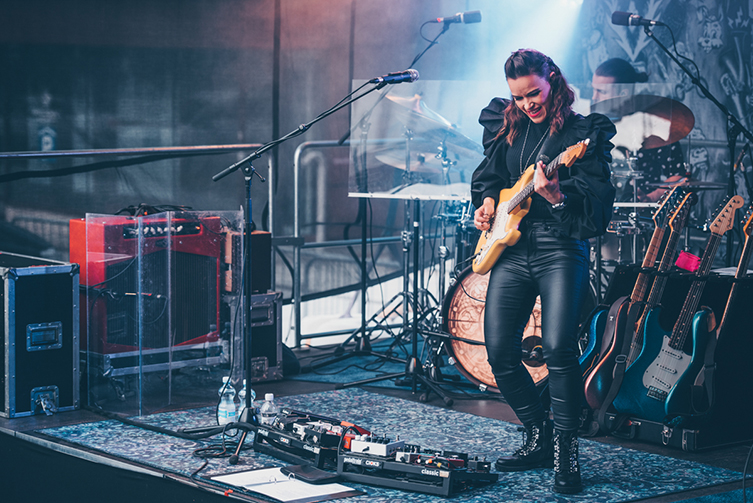
(photo: Jakko Manninen)
Yes, so in each guitar solo, I try to do something different: not just taking the obvious routes. Like in Run Away, I don’t know what the heck I’m doing with the slide, now when I’m listening back to it! I was so close to that solo when I was doing it: there were open string things, string hopping and funny things happening! When you’re in the project, you just deliver things, you know?
GG: Oh yeah.
EL: Then after you leave the project behind, you listen back and go, like: what is this? Did I really play all that? Yeah, I did! So, it was really interesting to make a slide solo for that song, particularly because that song is quite a basic rock-pop song, to my liking. So it was interesting to kind of shake it a bit and put a slide solo in there.
GG: Yeah! Slide is the thing I want to move onto next, but again you have read my mind: you have jumped into my brain and taken out my questions! I want to talk to you about the front cover. It’s absolutely stunning, and it’s one of those ones where I sometimes get asked, do I want to talk to this person or that person, but as soon as I saw that artwork, I thought: that person has got to be interesting, and worth talking to! That cover is so dynamic! There’s an association with cover art and the music within. For example, if I listen to Metallica’s Ride the Lightning album, the music sounds blue because of the cover, you know? And so, my question is, how far into the process of your record did that art show up? Did it show up early on and influence how things sounded? It’s really symbiotic with the music!
EL: Well, during the pre-production, I already started to see the cover in my mind. It’s important who you choose for your graphic designer and photographer and so I decided I was gonna use the guy who did Another World, my last one, because it has a great cover as well. On this one, we decided to use artificial intelligence on the cover.
GG: Ahhhh, right!
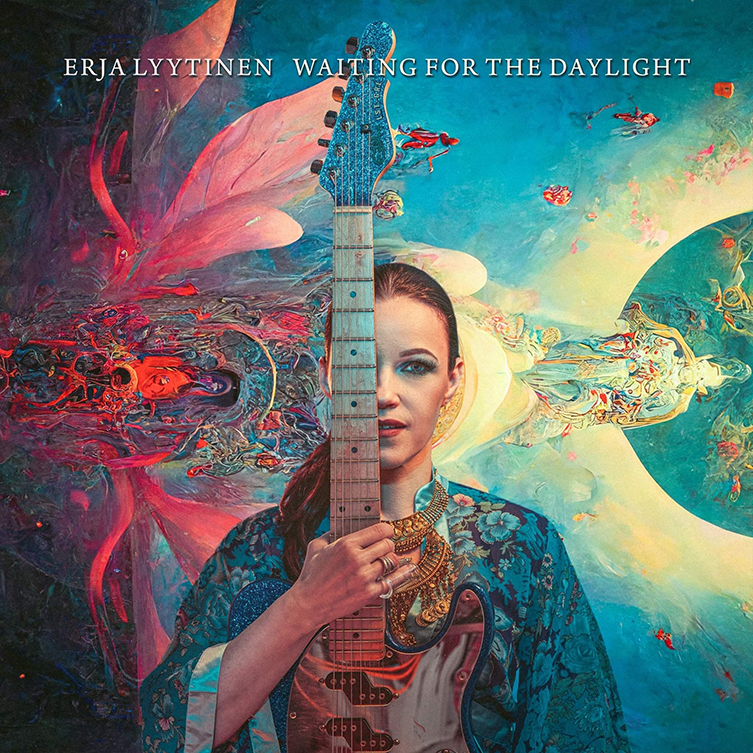
(photo: Erja Lyytinen)
EL: I had the colour already in my mind. I saw this face, with something round and a lot of elements and ornaments everywhere. Turquoise was the colour for the album: it was just in me that something like this had to be on the cover. So we shot the photographs and used artificial intelligence, and we’d feed the computer with some words from the album: some keywords and some feelings, some moments and some artforms. Then the computer started to suggest these backgrounds for us to use. I think it’s just brilliant: there are so many little things that even I haven’t had time to really dig into! (laughs) We have so many little details, and we did some little tricks there. You can see it in the headstock of the guitar: if you look closely, you might find something!
GG: Ah, ok! I’ll check it out!
EL: It’s very small! Maybe with the vinyl, it’s easier to notice what’s happening there, but we did some little tricks there. I like to do that.
GG: Talking about the guitar on the front cover there, that’s a spectacular G&L guitar. I’ve seen you photographed with that before, that sparkly one. Is that a particular favourite of yours?
EL: Actually, I got my first G&L guitars in the mid 2000s, and I fell in love with the looks of that one. I like glitter! (laughs)
GG: Oh yeah, it works! It’s beautiful!
EL: It’s a very beautiful guitar, but it definitely needed years of on-the-road, this guitar. I got it new and it was quite like all new guitars: they are beautiful and fine but they need to live! So, it’s been living with me for more than 15 years now. I’ve been playing almost all of my international shows with this guitar. It’s heavy and raw at the same time. It has pickups called Z-3, designed by G&L and they have quite a heavy output. It distorts quite easily compared to Stratocasters. It’s very cool, it’s my axe!
GG: It’s very eye-catching, and it works very well with the album artwork, so it was a good choice!
EL: I do play Fender guitars, and also on the album I played quite a lot of Ruokangas guitars, a Finnish guitar luthier.
GG: Is that the white one that’s in the Bad Seed video?
EL: Yeah, it is! It’s kind of a prototype that he gave to me. We have a couple of guitars from Ruokangas, we’ve been working together. (Erja picks up a guitar and brings it over) I might wanna change the neck but it’s a cool guitar!
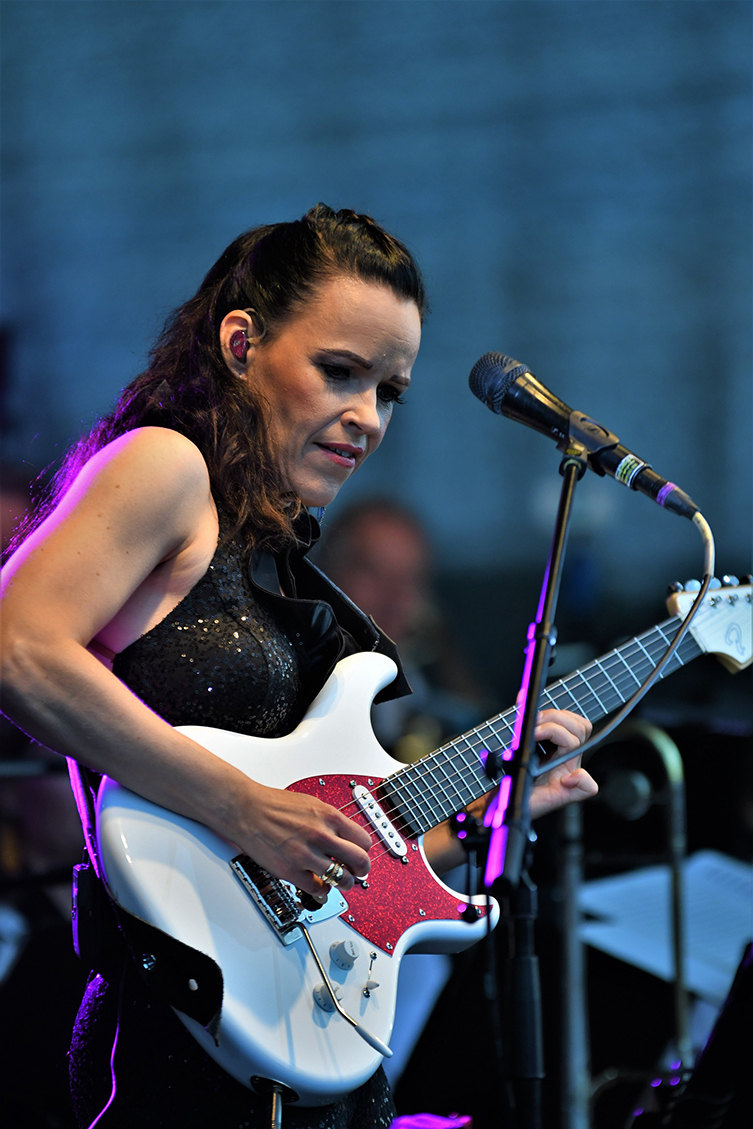
(photo: Hannu Juutilainen)
GG: Yes, that’s lovely!
EL: So I used the white one because, when I started to play it, it immediately spoke to me, it was really easy to play. The sound is really good and when I’m playing live on stage, I play heavier, because you’ve got all the energy and interaction with the audience, you know? It’s like going to the gym! But when you’re at the studio, you don’t really always get the same feeling because you are not at the same temperature, so to speak. You of course still play with force, but I noticed with that guitar, I played with force, but I could do things differently because the neck allowed me to do trickier, faster licks. For instance, in Bad Seed, I dunno where it came from but there’s this (makes a fast shredding sound and mime with her fingers), like, I dunno, 67 million notes! (laughs) I felt that it was because the guitar gave me the opportunity to express myself differently.
GG: Brilliant!
EL: Yeah!
GG: So, with that in mind, what I’m wondering about is, with your slide playing, do you differentiate, like do you have a different set of specific instruments that you have set up for slide? Presumably you have songs where you have to do both? How do you get around that?
EL: I just have loads of guitars with me. (laughs) Yeah, I usually have five guitars with me. I have separate guitars for open C tuning, open D and open G tuning. It’s because of the character, and then I don’t have to change the tuning for these guitars, they can just stay fixed in those tunings. Then I have a couple of regular tuned guitars with me. Different guitars have different sounds and it depends on the song you’re playing, so that’s why I like to change the guitars. It makes a huge difference to have a guitar properly set up for slide playing. I like to have strings quite high because it’s easier, but then again, if you want to take some chords with the slide - kind of Sonny Landreth style - then you should have the strings a bit closer to the fretboard. But I noticed I kinda like it when it’s up there (gestures a higher action), like on the G&L, the strings are up a bit. I think that must be one of the reasons why the volume is ‘heavier’, you know? And, I use D’Addario .012 strings.
GG: Ah, I see! What about the guitars you don’t play slide with? What gauge strings are those?
EL: .010.
GG: Right, tens. Now: slide questions! Which finger do you like to use for wearing the slide?
EL: Little finger.
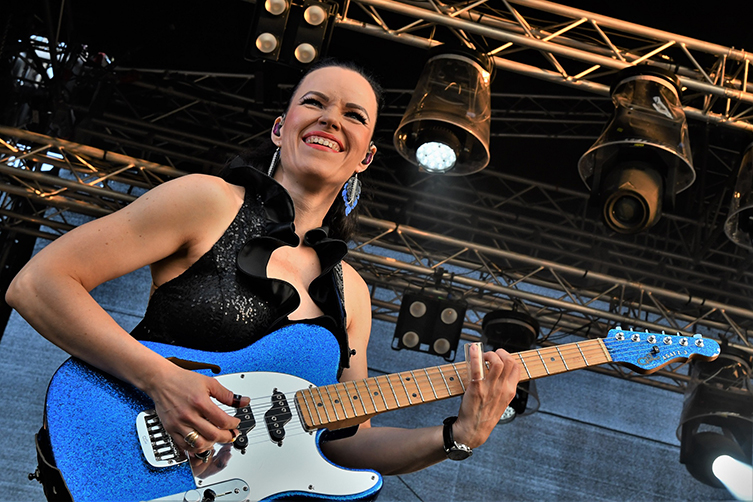
(photo: Hannu Juutilainen)
GG: And do you use your other fingers to mute the strings?
EL: Yes. Both hands, actually. When you start to practice guitar, muting is something you need to learn. When you master that, it's like an open world for you.
GG: Ok, yeah, I was going to ask: whenever I talk to a slide player, I find that everybody approaches the world of slide a little differently and I think your slide playing is fantastic. I wondered if there were any easy tips that you could pass on about how to approach slide playing? Anything at all that’s useful!
EL: Relax your left hand where your slide is! (laughs) Relax it! That’s the number one, I would say, because everybody tries to do the vibrato right away and it’s like (makes buzzing noise), a crazy, nervous vibrato! That tells you, ‘Oh, you haven’t played slide much!’ (laughs) So, yeah. Relax your left hand. Muting is important, and then just start to play with very simple melodies. Or take a scale or something, learn to play on one string, you know?
GG: Go up the way before you go across.
EL: Yes, that might help!
GG: That’s good advice! I always get interested in guitar picks. Do you have one you like best? And do you change it up for slide playing?
EL: Good question! I used to have Jazz III, the small one. Then my world changed when I changed to the XL. I think it gets the best sound and it’s quite thick. For me, this works the best at the moment. When I play acoustic guitar, I usually choose a lighter pick, a lot lighter. That’s also part of the sound. The song Last Girl, on the album, where I play a kind of American acoustic guitar like in a teen movie, I did it using a very light pick.
When I play slide guitar, I use fingerpicks. A thumbpick and a pick in my middle finger. It’s a lot of work! And sometimes I use the thumbpick like a regular pick, just holding it like normal. It’s not as accurate, it’s a bit looser, but still, I can do that and it’s nice to be able to play some chords and melodies at the same time. It’s kind of like Travis-picking with fingerpicks.
GG: Yeah, exactly!
EL: I remember when I was learning this, it really took a lot of time! (laughs) It’s not for the beginners!
GG: Definitely! You know what’s great? Because you were reading my mind all through that conversation, a lot of the things I wanted to ask, you’ve already answered! I’ve got a lot of great stuff here! So, the record is out on October 7th, I believe? And you’re touring both before and after the release, is that right?
EL: Yeah, we are actually touring the whole rest of the year. We start the record release tour in Germany on 7th October, and then we go to Finland to do some very cool club shows, and then we go to another very, very club tour in England! (laughs) It’s been over three years since I played in the UK! The pandemic really messed things up but little by little, we’ve started to climb the ladders again.
GG: We're looking forward to having you back over here!
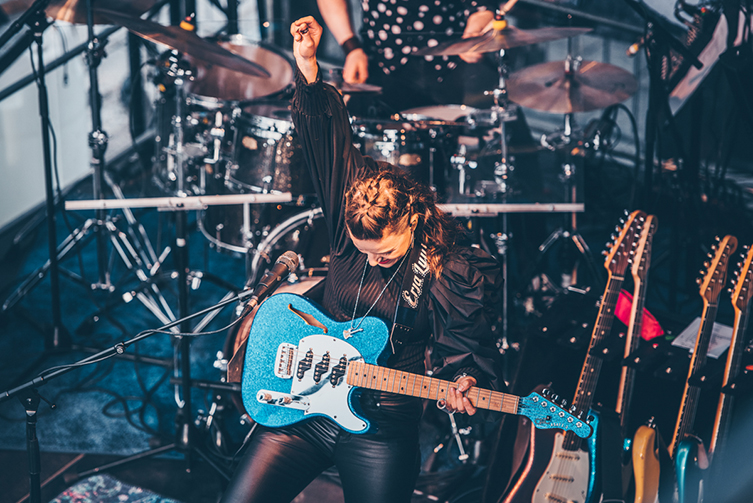
(photo: Jakko Manninen)
Erja was a real delight to talk to, and we can’t wait to catch her live show when her band makes it over here to the UK!
Erja Lyytinen’s new album “Waiting For The Daylight” is released by Tuohi Records on October 7th.
She tours the UK with Dom Martin from November 7-10th. Tickets and album info: www.erjalyytinen.com
We’d like to thank Erja for her time, and for giving us such a pleasant and entertaining conversation. We’d also like to thank Peter Noble for putting us in touch and generally being really helpful.
Thanks, as always, to yourself for reading another of our exclusive interviews! Please head over to our Interviews page for more from the likes of Steve Vai, Joe Satriani and many, many more!



